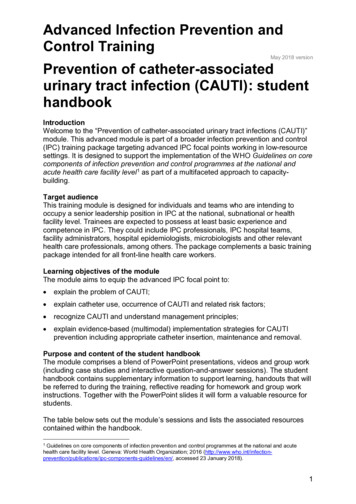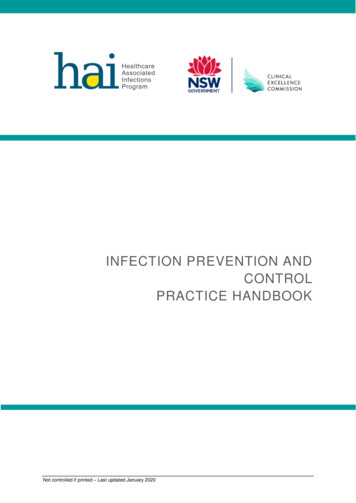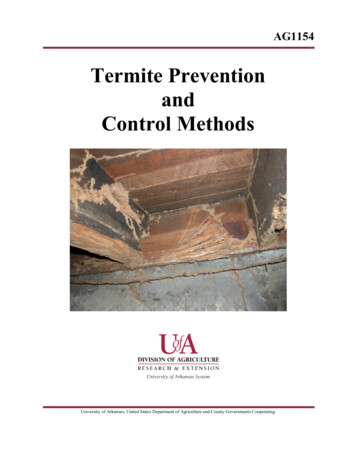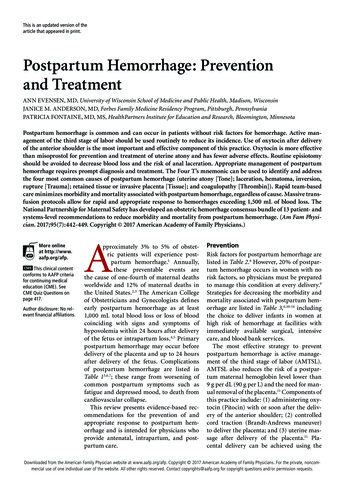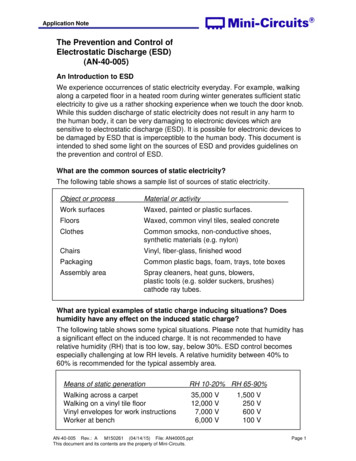
Transcription
Application NoteThe Prevention and Control ofElectrostatic Discharge (ESD)(AN-40-005)An Introduction to ESDWe experience occurrences of static electricity everyday. For example, walkingalong a carpeted floor in a heated room during winter generates sufficient staticelectricity to give us a rather shocking experience when we touch the door knob.While this sudden discharge of static electricity does not result in any harm tothe human body, it can be very damaging to electronic devices which aresensitive to electrostatic discharge (ESD). It is possible for electronic devices tobe damaged by ESD that is imperceptible to the human body. This document isintended to shed some light on the sources of ESD and provides guidelines onthe prevention and control of ESD.What are the common sources of static electricity?The following table shows a sample list of sources of static electricity.Object or processMaterial or activityWork surfacesWaxed, painted or plastic surfaces.FloorsWaxed, common vinyl tiles, sealed concreteClothesCommon smocks, non-conductive shoes,synthetic materials (e.g. nylon)ChairsVinyl, fiber-glass, finished woodPackagingCommon plastic bags, foam, trays, tote boxesAssembly areaSpray cleaners, heat guns, blowers,plastic tools (e.g. solder suckers, brushes)cathode ray tubes.What are typical examples of static charge inducing situations? Doeshumidity have any effect on the induced static charge?The following table shows some typical situations. Please note that humidity hasa significant effect on the induced charge. It is not recommended to haverelative humidity (RH) that is too low, say, below 30%. ESD control becomesespecially challenging at low RH levels. A relative humidity between 40% to60% is recommended for the typical assembly area.Means of static generationRH 10-20% RH 65-90%Walking across a carpetWalking on a vinyl tile floorVinyl envelopes for work instructionsWorker at bench35,000 V12,000 V7,000 V6,000 VAN-40-005 Rev.: A M150261 (04/14/15) File: AN40005.pptThis document and its contents are the property of Mini-Circuits.1,500 V250 V600 V100 VPage 1
Application NoteThe Prevention and Control ofElectrostatic Discharge (ESD)How does damage from ESD happen?When a statically-charged person or object touches an electrostatic discharge sensitive(ESDS) device, there is a possibility that the electrostatic charge could be drainedthrough sensitive circuitry in the device. If the electrostatic discharge possessessufficient energy, damage could occur in the device due to localized overheating.Generally, devices with finer geometries are more susceptible to damage from ESD.The modes in which ESD damage occurs are:(a)(b)(c)Discharge to the deviceDischarge from the deviceField-induced discharge.What are the classifications of ESD sensitivity?Electrostatic discharge sensitive (ESDS) parts are commonly characterized tothree defined models: Human Body Model (HBM)Machine Model (MM)Charged Device Model (CDM)Based on the models used, the ESDS parts can be classified in accordancewith the following table (per MIL-STD-1686C, with HBM subgroups per ESDSTM5.1-2001). It should be noted that the HBM, MM and CDM voltage levels donot correlate with each other.ESD ModelHuman Body Model (HBM)Machine Model (MM)Charged Device Model (CDM)ESD Voltage Range0V – 249V250V – 499V500V – 1999V1000 – 1999V2000 – 3999V4000 – 7999V 8000V0V – 100V101V – 200V201V – 400V401V – 800V 800V0V – 124V125V – 249V250V – 499V500V – 999V1,000V – 1,499V1,500V – 2,999V 3,000VWhat damage does ESD cause in an electronic device?There are basically two categories of damage from ESD:(a) Catastrophic damage – the electronic device is rendered inoperableimmediately after the ESD event. A semiconductor junction or a connectingmetallization could have been damaged by the electrostatic discharge.(b) Latent damage – the electronic device appears to be working fine following theESD event. However, the sensitive circuitry has been damaged and could failto operate properly at some time in the future.AN-40-005 Rev.: A M150261 (04/14/15) File: AN40005.pptThis document and its contents are the property of Mini-Circuits.Page 2
Application NoteThe Prevention and Control ofElectrostatic Discharge (ESD)Detection of static charges in the work area.A commonly used tool for the detection of static charges is the electrostatic fieldmeter. This tool, when used in conjunction with regular audits on the productionfloor, is very effective in detecting the presence and magnitude of staticcharges. Care should be exercised to ensure adherence to the measurementdistance as the meter is calibrated to specific distances from the measuringplane. Please consult the user’s guide on the correct measuring distance for thespecific electrostatic field meter model that is being used.Protection for Electrostatic Discharge Sensitive (ESDS) devices.(A) Work area:1. It is essential to handle ESDS devices at static-safe workstations. Thiswill prevent yield loss (through catastrophic damage) or, worse,potential reliability failures in the field (through latent damage).2. Where it is impractical or impossible to use antistatic wrist-straps orremove items that are composed of insulative materials at a static-safeworkstation, use an air ionizer designed to neutralize electrostaticcharges or apply topical antistats to control generation andaccumulation of static charges.3. When an air ionizer is utilized, it is vital that maintenance proceduresand schedules are adhered to in order to ensure that ions generated bythe ionizer are sufficiently balanced.4. Avoid bringing sources of static electricity (as shown in page 1) within 1meter of a static-safe work bench.5. Where it is necessary to use air-guns, use special models that do notgenerate static charges in the air stream.(B) Personnel:1. Any accumulated charge on the body of the human operator should bedischarged first before opening the protective container with ESDSdevices inside. The discharge can be accomplished by putting a handon a grounded surface or, ideally, by wearing a grounded antistaticwrist-strap.2. The use of an antistatic smock for each worker is highly recommended.3. Education and training on ESD preventive measures is invaluable.4. A regular audit is also helpful in supporting an ESD program.(C) Packaging and Transportation: ESDS devices should be contained in a static protective bag orcontainer at all times during storage or transportation.AN-40-005 Rev.: A M150261 (04/14/15) File: AN40005.pptThis document and its contents are the property of Mini-Circuits.Page 3
Application NoteThe Prevention and Control ofElectrostatic Discharge (ESD)Static-safe work bench.The diagram below shows a typical static-safe work bench. The table top iscovered by a static dissipative mat which is grounded through a 1 Meg-ohmresistor. This resistor is required in order to protect the users of the static-safework bench – in the event that the ground becomes electrically live, the resistorwill prevent electrical shock at the work bench. The same safety requirementholds true for the antistatic wrist-strap as well.GroundPointESD protective wrist strapStatic dissipative table topMonitor UnitGroundable pointESD protective floor matWhat materials are suitable for dissipating static electricity?It is recommended that static dissipative materials are used as the medium (e.g.mats, containers) for discharging static charge to ground. These materials havethe following properties:Surface resistivity: 1 x 105 to 1 x 1012 ohms/sqVolume resistivity: 1 x 104 to 1 x 1011 ohm-cmCautionary note: Materials which are conductive (e.g. stainless steel surfaces)are not recommended for use as a static-safe work surface; the low electricalresistance could result in a transient-like (surge) discharge of static electricity.A rapid discharge is far more damaging to the electronic device than a graduallypaced discharge through a static dissipative material.AN-40-005 Rev.: A M150261 (04/14/15) File: AN40005.pptThis document and its contents are the property of Mini-Circuits.Page 4
Application NoteThe Prevention and Control ofElectrostatic Discharge (ESD)An example of a static-safe work bench (at Electrical Test).The picture below shows an example of a static-safe work bench. It is vitallyimportant that the wrist-strap and the table mat are securely grounded (throughthe 1 Meg-ohm safety resistor). In addition, all other materials with which theproducts come into contact must also be static-safe. The use of an antistaticfloor further enhances the protective capabilities of a static-safe workenvironment. The worker should also wear an antistatic smock.Antistatic tweezersAntistatic finger cotsAntistatic carrier tapeAntistatic bagGrounded wrist-strapAntistatic table matAntistatic floor tilesAN-40-005 Rev.: A M150261 (04/14/15) File: AN40005.pptThis document and its contents are the property of Mini-Circuits.Page 5
Application NoteThe Prevention and Control ofElectrostatic Discharge (ESD)An example of a Static Control Test Station.The picture shows an example of a test station used to determine whetherantistatic wrist-straps or antistatic shoes are working properly.A green test indicator light meansthe wrist-strap is worn properlyand is working as intended. Thispicture shows the configuration fortesting wrist-straps. The teststation can also be configured totest antistatic footwear.Antistatic footwear.Where a wrist-strap is impractical, e.g. the jobrequires the worker to walk from one locationto another, it is recommended that antistaticfootwear such as antistatic shoes or heelstraps are worn. The picture on the rightshows an example of an antistatic heel-strapwith the grounding cord running into the socksto make contact with the skin. It is alsonecessary to use an antistatic floor(e.g. conductive floor tiles) to work togetherwith the antistatic footwear.AN-40-005 Rev.: A M150261 (04/14/15) File: AN40005.pptThis document and its contents are the property of Mini-Circuits.Page 6
Application NoteThe Prevention and Control ofElectrostatic Discharge (ESD)Labels to identify electrostatic discharge sensitive (ESDS) devices.The following labels are commonly used on containers and packaging to alertanyone who handles the ESDS devices on the need to use static-safeprocedures before handling the devices. The one on the left is preferred.The following verbiage should be placed beside the label:CAUTIONContains parts andassemblies susceptible to damage byElectrostatic Discharge (ESD)ReferencesANSI/ESD S8.1-1993“ESD Awareness Symbols”ANSI/ESD S20.20“ESD Association Standard for the Development of an Electrostatic DischargeControl Program”ESD STM5.1-2001“Electrostatic Discharge Sensitivity Testing -- Human Body Model (HBM)Component Level”MIL-HDBK-263“Electrostatic Discharge Control Handbook for Protection of Electrical andElectronic Parts, Assemblies and Equipment (excluding electrically-initiatedexplosive devices)”MIL-STD-1686C“Electrostatic Discharge Control Program for Protection of Electrical andElectronic Parts, Assemblies and Equipment (excluding electrically-initiatedexplosive devices)”JESD625-A“Requirements for Handling Electrostatic-Discharge-Sensitive (ESDS) Devices.”AN-40-005 Rev.: A M150261 (04/14/15) File: AN40005.pptThis document and its contents are the property of Mini-Circuits.Page 7
Application NoteIMPORTANT NOTICE 2015 Mini-CircuitsThis document is provided as an accommodation to Mini-Circuits customers in connection with Mini-Circuits parts only. Inthat regard, this document is for informational and guideline purposes only. Mini-Circuits assumes no responsibility for errorsor omissions in this document or for any information contained herein.Mini-Circuits may change this document or the Mini-Circuits parts referenced herein (collectively, the “Materials”) from time totime, without notice. Mini-Circuits makes no commitment to update or correct any of the Materials, and Mini-Circuits shallhave no responsibility whatsoever on account of any updates or corrections to the Materials or Mini-Circuits’ failure to do so.Mini-Circuits customers are solely responsible for the products, systems, and applications in which Mini-Circuits parts areincorporated or used. In that regard, customers are responsible for consulting with their own engineers and otherappropriate professionals who are familiar with the specific products and systems into which Mini-Circuits’ parts are to beincorporated or used so that the proper selection, installation/integration, use and safeguards are made. Accordingly, MiniCircuits assumes no liability therefor.In addition, your use of this document and the information contained herein is subject to Mini-Circuits’ standard terms of use,which are available at Mini-Circuits’ website at www.minicircuits.com/homepage/terms of use.html.Mini-Circuits and the Mini-Circuits logo are registered trademarks of Scientific Components Corporation d/b/a Mini-Circuits.All other third-party trademarks are the property of their respective owners. A reference to any third-party trademark doesnot constitute or imply any endorsement, affiliation, sponsorship, or recommendation: (i) by Mini-Circuits of such third-party’sproducts, services, processes, or other information; or (ii) by any such third-party of Mini-Circuits or its products, services,processes, or other information.AN-40-005 Rev.: A M150261 (04/14/15) File: AN40005.pptThis document and its contents are the property of Mini-Circuits.Page 8
The Prevention and Control of Electrostatic Discharge (ESD) (AN-40-005) An Introduction to ESD. We experience occurrences of static electricity everyday. For example, walking along a carpeted floor in a heated room during winter generates sufficient static electricity to give us

